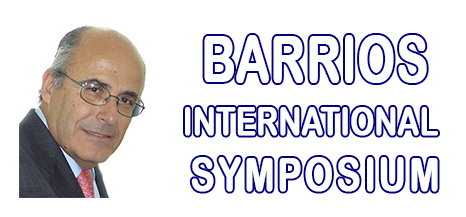List of Accepted Abstracts As of 18/12/2025: (Alphabetical Order)
Barrios Intl. Symp on Sustainable Non-ferrous Smelting and Hydro/Electrochemical Processing
Dodds Intl Symp: on Sustainable Energy Production: Fossil; Renewables; Nuclear; Waste handling , processing, and storage for all energy production technologies; Energy conservation
Gaune-Escard Intl Symp: on Sustainable Molten Salt and Ionic Liquid Processing
Goodall Intl. Symp. on Sustainability of World Ecosystems in Anthropocene Era
Lotter Intl Symp. on Sustainable Mineral Processing: Principles, Technologies and Industrial Practice
Marquis Intl. Symp. on New and Advanced Materials and Technologies for Energy, Environment and Sustainable Development
Intl. Symp. on Advanced Sustainable Iron and Steel Making
Intl. Symp. on Sustainable Metals & Alloys Processing
Intl. Symp. on Sustainable Aluminum Extraction and Processing
Intl. Symp. on Sustainable Secondary Battery Manufacturing and Recycling
Intl. Symp. on Multiscale Material Mechanics and Multiphysics and Sustainable Applications
Intl. Symp. on Sustainable Mathematics Applications
Intl. Symp. on Sustainable Surface and Interface Engineering: Coatings for Extreme Environments
Intl. Symp. on Composite, Ceramic and Nano Materials Processing, Characterization and Applications
Intl. Symp. on Environmental, Health, Policy, Legal, Management and Social Issues Related to Metals, Materials and Mineral Processing
Intl. Symp. on Sustainable Mining Operations
Intl. Symp. on Synthesis and Properties of Nanomaterials for Future Energy Demands
Intl. Symp. on Rare Earth and Platinum Group Metals: Managing and Processing
Intl. Symp. on Sustainable Materials Recycling Processes and Products
Intl. Symp. Surfaces and Interfaces of Sustainable, Advanced Materials (SISAM)
Summit Plenary
INTL. SYMP. ON MULTISCALE MATERIAL MECHANICS AND MULTIPHYSICS AND SUSTAINABLE APPLICATIONSTo be Updated with new approved abstracts [Defects on solids ]
Fracture Mechanics Tests with the Use of Miniaturized Test Specimens
Libor
Kraus1; Martin Rund2; Jan Dzugan3; Danile Melzer4;
1COMTES FHT INC., Dobrany, Czech Republic; 2COMTES FHT, Dobrany, Czech Republic; 3COMTES FHT, Donrany, Czech Republic; 4, , ;
Type of Paper: Regular
Type of Presentation: Poster
Id Paper: 117
Topic: 1Determination of mechanical properties with the use of sub-sized specimens is a topic of high interest nowadays. The application of the sub-sized samples is quite wide for all cases where only limited amount of the experimental material is available such as evaluation of additively manufactured products properties, residual life of in-service components, properties determination of developed nanostructured materials, assessment of dilatometric samples used for thermal and thermo-mechanical treatment development, local properties of components, weld joints, etc. Concerning this large application field, it would be very useful to prepare a standard for small size samples, especially for most demanded material properties: tensile properties, notch impact transition temperature, fatigue properties, fracture toughness and creep. The current work is dealing with fracture toughness employing master curve and J-R curve approaches for fracture toughness parameters determination with the use mini specimens. The experimental material is reactor pressure vessel steel provided in the form of 2T-CT specimens. These specimens are tested and from the broken halves 1T-CT specimens are machined as well as full-size Charpy specimens, mini 0.16T-CTs and mini Charpy specimens. Results of fracture toughness tests achieved for different size specimens are subsequently compared and the size effect in assessed.
Keywords: Characterization; Mechanics; Metals; Steel;
Nanocarbon Foams: Fabrication, Characterization, and Application
Mei
Zhang1;
1FLORIDA STATE UNIVERSITY, Tallahassee, United States;
Type of Paper: Invited
Type of Presentation: Oral
Id Paper: 313
Topic: 1Nanocarbon foam is a carbon nanotube based all carbon porous material. It consists of large numbers of micro-scale cells and sub-micro thick walls with nano-scale pores. Because of their unique structures, the nanocarbon foams show high capillary pressure, super-absorption, large working fluid storage, and fast fluid transfer capabilities. They are also conductive, lightweight, stable, and flexible. These features allow nanocarbon foams to be a novel wick material for thermal management products and have a better performance than current wick materials. The simple and scalable fabrication process could lead to low cost and high quality device manufacturing. The lightweight, super-elastic, and high stability properties of nanocarbon foams make them a unique alternative for the thermal management of portable and flexible electronic devices. In addition to thermal management, other applications of nanocarbon foams include use in electrodes for advanced batteries, in fuel cells, in pressure sensors, and in scaffolds for medical treatments. The detailed fabrication process, property characterization, and potential applications will be presented.
Keywords: Nanomaterials; Nanotechnology; Nanotubes;
[Gradient Elasticity ]
Surface Stresses on the Size-dependent Behaviors of a Microplate
K.y.
Xu1; Yanmei Yue2;
1SHANGHAI UNIVERSITY, Shanghai, China; 2SHANGHAI UNIVERSTIY, Shanghai, China;
Type of Paper: Regular
Type of Presentation: Oral
Id Paper: 37
Topic: 1The present paper develops a size-dependent Kirchhoff microplate model with surface effects by using simplified strain gradient elasticity theory and modified surface elasticity theory. This new model is able to capture size-dependent behaviors and surface effects. The most noticeable difference of the proposed model from the existing plate models about micro-plates is that not only strain gradient and surface stress are taken into account, but also the surface-induced internal residual stresses are considered. Based on whether the plates having surface-induced internal residual stress or not, their governing equations have distinct differences. The new plate model is applied to analyze the size-dependent bending, buckling, and free vibration behaviors of simply supported Kirchhoff microplate. The influence of surface-induced internal residual stresses is explored in this paper as well. The numerical results reflect that when the simply supported microplates do not have surface-induced internal residual stresses, internal length scale and surface residual stress have significant influence on the bending, buckling, and free vibration behaviors of the microplates. However, when the simply supported microplates have nonzero surface-induced internal residual stresses, the effects of internal length scale and surface residual stress become very weak. It indicates that the effect of surface-induced internal residual stresses can counteract most of the effects of internal length scale and surface residual stress. Therefore, this work provides a more general model for the analysis of microplate problems.
Keywords: Materials; Mechanics; Microscale; Surface;
|







